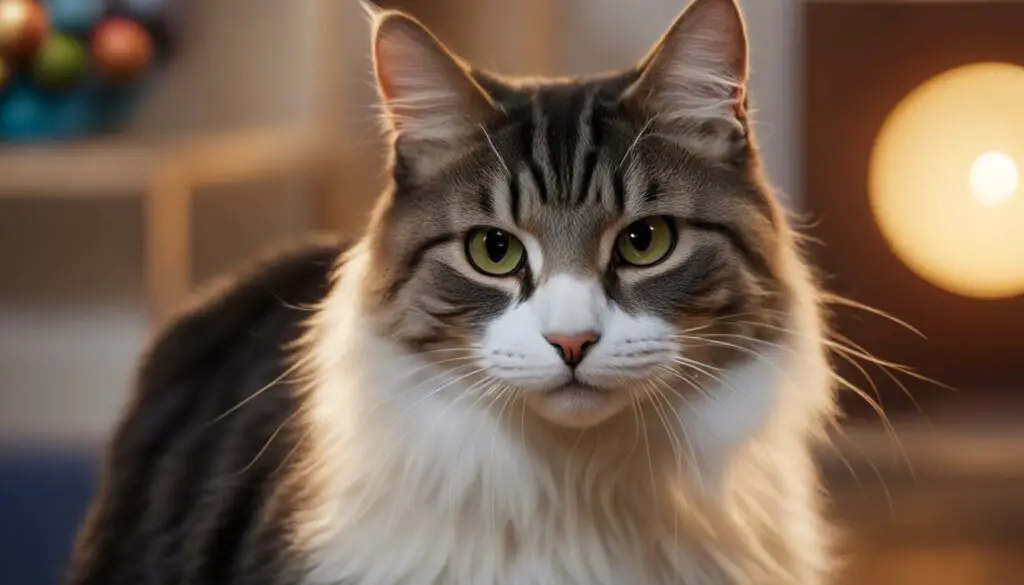Have you ever wondered why your cat seems to meow only at you and not at others? It’s important to understand that cat meowing behavior is a form of feline communication, and it is directed towards humans rather than other cats. Your cat meows as a way to interact with you and convey their needs and desires. By understanding their unique vocalizations, you can better communicate and strengthen the bond with your feline companion.
Key Takeaways:
- Cat meowing is a form of communication directed towards humans.
- Cats meow to get your attention and convey their needs and desires.
- Understanding their meows can help strengthen the bond between you and your cat.
- Meows can indicate hunger, boredom, or simply a desire to say hello.
- Pay attention to the context and body language accompanying your cat’s meows to accurately interpret their messages.
The Meaning Behind Cat Meows
When it comes to understanding our feline friends, it’s important to decipher the meaning behind their meows. Cats use vocalizations as a way to communicate with their human companions, expressing a range of needs and emotions. By interpreting their meows, we can strengthen the cat-human bond and ensure a deeper understanding of our furry friends.
Meows can have different meanings depending on the context. A short and friendly meow is often a way for your cat to greet you or say hello. It’s their way of showing affection and acknowledging your presence. On the other hand, a long and persistent meow may indicate that your cat is seeking attention or wants something specific, such as food or playtime. By paying attention to the length, pitch, and intensity of their meows, we can better understand their needs and respond accordingly.
It’s important to note that meows are not the only form of communication from cats. They also use body language and other vocalizations such as purring, hissing, and growling to express themselves. By observing their meows in conjunction with their body language, we can gain a more comprehensive understanding of what our cats are trying to communicate. For example, a meow accompanied by a raised tail and purring may indicate contentment and happiness, while a meow paired with flattened ears and a bristled tail may signal fear or aggression.
Understanding cat vocalizations is key to building a strong bond with your feline companion. By interpreting their meows alongside their body language, we can respond appropriately to their needs and create a more fulfilling relationship.
Table: Decoding Cat Meows
| Meow Type | Possible Meaning |
|---|---|
| Short, friendly meow | Greeting or acknowledgment |
| Long, persistent meow | Seeking attention or specific needs |
| Repetitive meows | Expressing desire for play or interaction |
| Distressed or intense meow | Signaling pain, fear, or discomfort |
By paying close attention to the meaning behind our cats’ meows and their accompanying body language, we can establish a stronger connection with them. Responding to their needs and desires not only ensures their well-being but also fosters a deeper sense of trust and understanding. So the next time your cat meows, take a moment to listen and decipher their unique language.
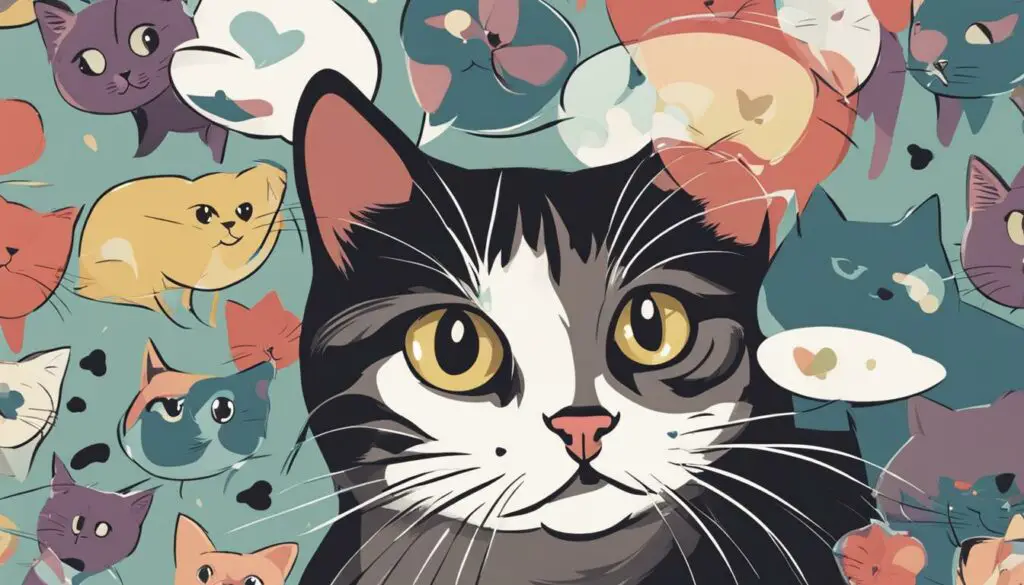
Why Cats Meow to Humans
When it comes to communicating, cats have a unique language specially designed for their human companions. Unlike their interactions with other cats, cats primarily meow to humans. Meowing is their way of trying to engage and communicate their needs, desires, or simply to initiate contact with humans.
While it is not fully understood why cats developed this specific form of communication with humans, it is believed to be a result of their domestication and their desire to interact and bond with their human caregivers. Cats have learned that meowing is an effective way to catch our attention and convey their messages.
As cat owners, it’s important to pay attention to their meows and try to understand what they’re trying to communicate. Each meow can have a different meaning based on the context and accompanying body language. By observing their behavior and responding appropriately, we can strengthen the bond with our feline companions and ensure their needs are met.
The Unique Cat Language
Cats have a wide range of vocalizations, and each meow can have its own unique meaning. Some meows may be a simple greeting, while others may indicate hunger, boredom, or a desire to play. By paying attention to the pitch, length, and intensity of their meows, we can start to decipher their unique language.
It’s important to remember that meowing is just one part of a cat’s overall communication repertoire. They also use body language, such as tail movements, ear positions, and pupil dilation, to convey their emotions and intentions. By considering their meows in conjunction with their body language, we can gain a more complete understanding of what our cats are trying to tell us.
So the next time your cat meows, take a moment to observe their behavior and respond accordingly. By understanding their unique language and engaging in cat-human communication, we can deepen our bond with our feline friends and provide them with the love and care they need.
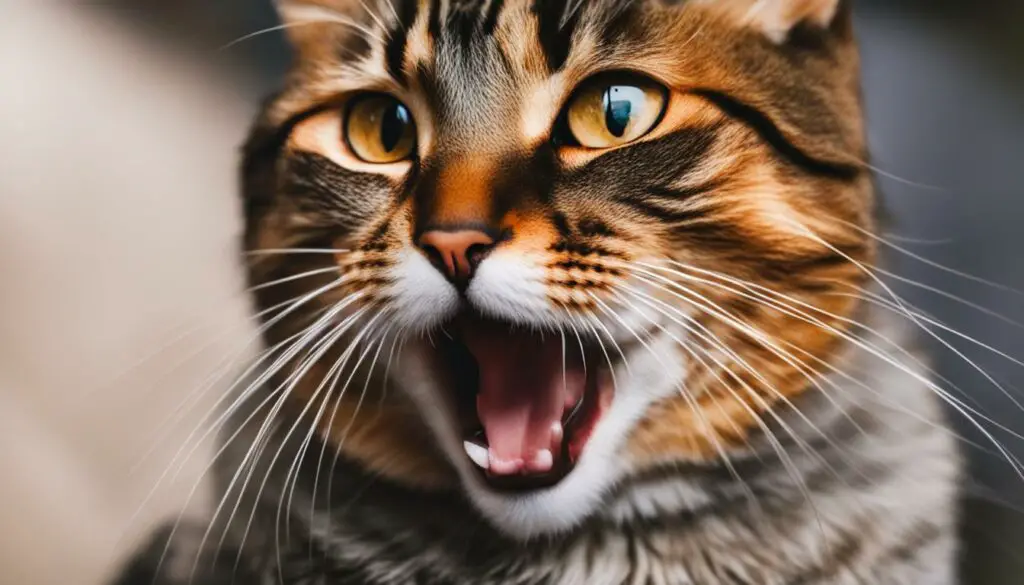
Different Types of Meows and Their Meanings
Meows can vary in length, pitch, and intensity, each conveying a different message from your feline companion. Understanding these different types of meows can help you better respond to your cat’s needs and strengthen your bond. Here are some common types of meows and their meanings:
1. Greeting Meows
Short, soft meows are often used by cats as a way of greeting their humans. It’s their way of saying hello and acknowledging your presence. These meows are generally accompanied by a friendly body posture, such as an upright tail and relaxed ears.
2. Attention-Seeking Meows
Longer and more insistent meows are often used by cats to get your attention. They may want you to pet them, play with them, or provide them with food or water. These meows can be accompanied by rubbing against your legs or pawing at you to get your attention.
3. Expressive Meows
Cats use a variety of meows to express their emotions. A high-pitched, urgent meow may indicate excitement or happiness, while a low, drawn-out meow may signal frustration or discontent. Paying attention to the context and accompanying body language can help you understand the specific emotion behind their meow.
4. Meows for Assistance
Some cats may use a distinctive meow to indicate that they need help or are in distress. These meows may sound more urgent and intense than their regular meows, and they may be accompanied by pacing, restlessness, or other signs of discomfort. It’s important to pay attention to these meows and assess your cat’s well-being.
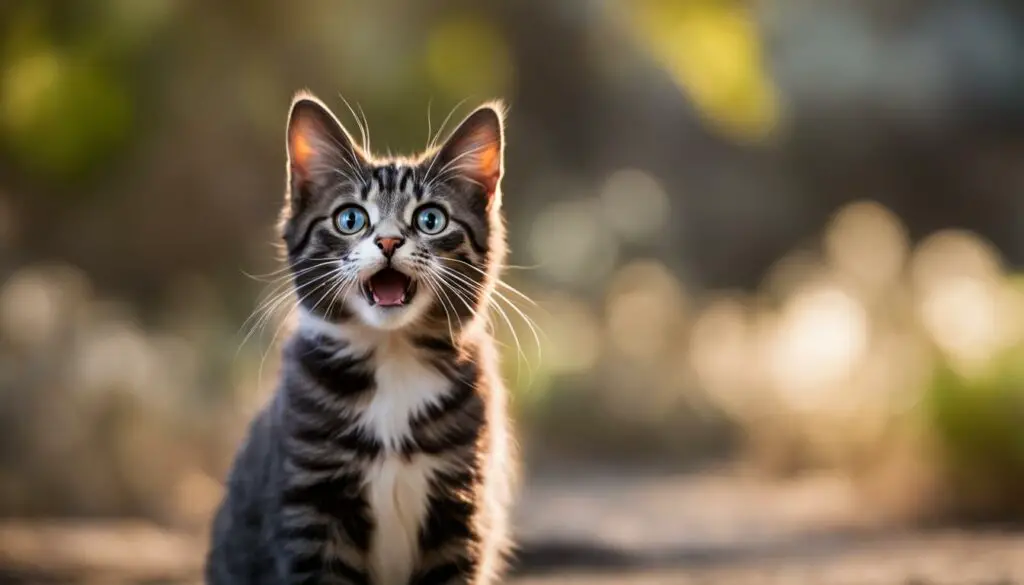
Understanding and responding appropriately to your cat’s meows can enhance your communication and strengthen your bond. By paying attention to the different types of meows and their meanings, you can better meet your cat’s needs and ensure their overall well-being.
Cats Meow for Attention and Connection
When your cat meows, it’s often a way of seeking attention and connection with you. Cats are social creatures, and meowing is their way of communicating their desire for interaction and engagement. Whether they’re softly meowing to get your attention or vigorously vocalizing to express their needs, responding to their meows can strengthen the bond between you and your feline companion.
Connecting with your cat through their meows involves more than just hearing the sound. It’s also about understanding their body language and the context in which they’re meowing. Observing their posture, tail movements, and facial expressions can provide valuable clues about their needs and emotions.
“Meowing is their way of engaging with you and creating a bond.”
By responding to your cat’s meows with attention, petting, playtime, or treats, you can show them that you’re there for them. This positive reinforcement not only fulfills their desire for attention but also reinforces the bond between you and your cat. Remember to use a calm and soothing tone of voice when interacting with your cat, as they are sensitive to emotions and cues from their human companions.
Benefits of Bonding through Meowing:
- Strengthens the bond between you and your cat
- Enhances communication and understanding
- Creates a sense of security and trust
- Promotes positive behavior and reduces stress
Connecting Through Meowing and Physical Contact:
| Meowing | Physical Contact |
|---|---|
| Soft, gentle meows | Gentle stroking and petting |
| Intense, persistent meows | Playful interaction and active engagement |
| Purring and kneading | Close cuddling and lap-sitting |
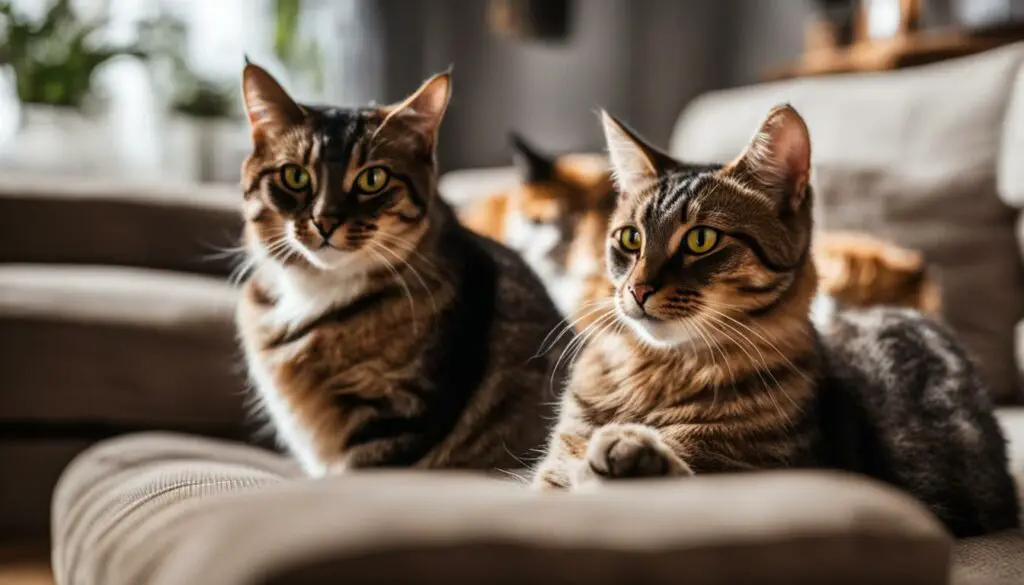
Bonding with your cat through their meows not only fosters a deeper connection but also allows you to better understand their needs and emotions. By responding to their meows and providing the attention and affection they seek, you can create a loving and harmonious relationship with your feline companion.
Distressed Meows and Signs of Trouble
Distressed meows in cats can serve as important indicators of their well-being. It is essential for us as cat owners to be attentive and recognize signs of distress in our furry companions. Cats may exhibit unusual or agitated meowing patterns when they are experiencing pain, fear, or stressful situations. It is crucial to pay attention to these distress meows and take appropriate action to address their needs.
Signs of distress in cats can manifest in different ways, including changes in the intensity or pitch of their meows. For example, a normally quiet cat who suddenly starts meowing loudly and incessantly may be signaling that something is wrong. Other signs of distress can include pacing, hiding, aggression, or excessive grooming. It is important not to ignore these behaviors and to seek professional help if needed.
If you notice your cat meowing for help in a distressed manner, it is important to assess their surroundings and determine potential triggers. Cats can become stressed due to changes in their environment, such as the presence of new pets, a move to a new home, or loud noises. By identifying and addressing these stressors, we can help alleviate their distress and create a calm and secure environment for our cats.
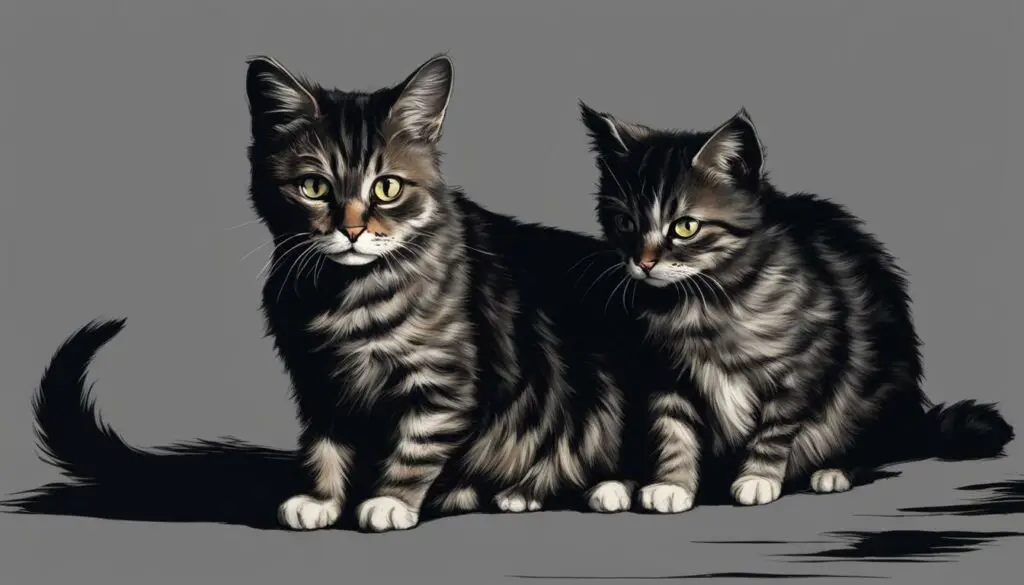
Common Signs of Distress in Cats
- Excessive meowing, especially if it sounds different or more intense
- Agitated behavior, such as pacing or restlessness
- Inappropriate elimination outside the litter box
- Hiding or seeking isolation
- Increased aggression or irritability
- Excessive grooming or overgrooming in certain areas
If you observe any of these signs of distress in your cat, it is crucial to consult with a veterinarian. They can help determine the underlying cause of the distress and provide appropriate treatment or management strategies. Remember, as responsible cat owners, it is our duty to ensure the well-being and happiness of our feline friends.
| Signs of Distress | Possible Causes |
|---|---|
| Excessive meowing | Pain, fear, stress, attention-seeking |
| Agitated behavior | Environmental changes, discomfort, fear |
| Inappropriate elimination | Stress, anxiety, medical issues |
| Hiding or seeking isolation | Fear, discomfort, stress |
| Increased aggression | Pain, fear, territorial behavior |
| Excessive grooming | Anxiety, skin irritation, medical issues |
Meows as Indicators of Health Issues
When it comes to our furry feline friends, their meowing patterns can serve as important indicators of their overall health. Changes in a cat’s meowing behavior can be a sign that something may be wrong, and it’s crucial for pet owners to pay attention and take action. Excessive meowing, distressed-sounding meows, or a significant departure from their normal meowing behavior may be signs of pain, illness, or cognitive decline.

In some cases, an increase in meowing frequency could be a sign that a cat is experiencing pain or discomfort. Cats may meow more frequently when they’re suffering from conditions like urinary tract infections, dental problems, or arthritis. Conversely, a sudden decrease in meowing or a change in the pitch or intensity of their vocalizations could indicate a more serious underlying health issue. It’s important for pet owners to monitor their cat’s meows and seek veterinary advice if they notice any significant changes.
Possible Health Issues Associated with Meowing Changes
- Urinary tract infections
- Dental problems
- Arthritis
- Hyperthyroidism
- Respiratory infections
- Gastrointestinal issues
Additionally, changes in meowing patterns can also be a potential indicator of cognitive decline in older cats. Feline Cognitive Dysfunction Syndrome (FCDS) can cause cats to become disoriented, confused, and irritable, leading to increased vocalizations. If your aging cat’s meowing patterns change and they exhibit other signs of cognitive decline such as forgetfulness or increased restlessness, it’s important to consult with a veterinarian for proper diagnosis and management.
| Meowing Behavior | Possible Health Issue |
|---|---|
| Excessive meowing or meowing more frequently than usual | Urinary tract infections, dental problems, arthritis |
| Significant decrease in meowing or change in pitch and intensity | Underlying health issues such as hyperthyroidism, respiratory infections, gastrointestinal issues |
| Increase in meowing in older cats with other signs of cognitive decline | Feline Cognitive Dysfunction Syndrome (FCDS) |
Understanding and monitoring your cat’s meowing patterns can help you detect potential health issues early on and ensure their well-being. If you notice any concerning changes in their vocalizations, it’s always best to consult with a veterinarian who can provide professional guidance and appropriate care for your beloved furry companion.
Meowing and Aging
As cats age, they may experience cognitive decline, just like humans. This can result in changes in their meowing behavior. Older cats may meow more frequently or exhibit different patterns of vocalization. Feline Cognitive Dysfunction Syndrome can cause cats to become disoriented, confused, and irritable, leading to increased vocalizations. It is important for cat owners to provide support and seek veterinary guidance to ensure the well-being of their aging feline friends.
One common aspect of meowing in senior cats is the increased frequency of vocalizations. As cats age, they may become more vocal, using meows as a way to express their needs and emotions. This can be attributed to changes in their cognitive function and sensory perception. Therefore, it is crucial for cat owners to pay close attention to any changes in their senior cat’s meowing patterns and seek professional advice if necessary.
In addition to increased meowing, senior cats may also exhibit changes in the quality of their vocalizations. Their meows may sound different, either softer or more strained, and their pitch may vary. These changes can be linked to age-related changes in their vocal cords and muscles involved in meowing. While these changes can be a natural part of the aging process, they can also be a sign of underlying health issues. It is important for cat owners to monitor their senior cats closely and consult with a veterinarian if any abnormal changes are observed.
| Common Changes in Meowing Behavior in Senior Cats | Possible Causes |
|---|---|
| Increased frequency of meowing | Feline Cognitive Dysfunction Syndrome, sensory changes |
| Changes in the quality of meows | Age-related changes in vocal cords and muscles, underlying health issues |
| Disoriented or confused vocalizations | Feline Cognitive Dysfunction Syndrome |
Supporting senior cats with cognitive decline can involve creating a safe and stimulating environment for them. Providing consistency in routines, maintaining familiar surroundings, and engaging them in gentle physical and mental exercises can help alleviate some of the symptoms associated with cognitive decline. Additionally, a balanced and age-appropriate diet, along with regular veterinary check-ups, is essential for the overall well-being of senior cats.
Talking to Your Cat
When it comes to communicating with your cat, understanding their language cues and body language is key. While cats may not understand human words, they appreciate the interaction and attention they receive when you talk to them. Speaking calmly and maintaining consistent body language can establish effective communication and strengthen the bond between you and your feline friend.
Observing your cat’s body language cues can provide valuable insights into their needs and emotions. Pay attention to their ear position, tail movements, and pupil size, as these can give clues about their mood and intentions. By learning to decipher their non-verbal cues, you can better understand their meows and communicate more effectively with your cat.
Positive reinforcement is essential in building a positive communication experience with your cat. Cats are sensitive to emotions and cues from their human companions, so maintaining a calm and positive tone of voice is crucial during interactions. Avoid frustrating or negative responses, as they can increase stress and impact the communication dynamic. By using consistent, cat-friendly tones and rewarding desired behaviors, you can foster a more positive and effective communication experience.
| Cue | Meaning |
|---|---|
| Ears forward | Engaged and interested |
| Flattened ears | Agitated or scared |
| Tail up or slightly curved | Friendly and confident |
| Tail twitching | Alert or excited |
| Pupils dilated | Highly stimulated or anxious |
“Understanding your cat’s body language is like learning a secret code. It allows you to connect with them on a deeper level and respond to their needs more effectively.”
By talking to your cat, observing their body language, and using positive reinforcement, you can establish clear communication and strengthen your bond. Remember, cats have their unique way of expressing themselves, and by paying attention to their cues, you can build a meaningful connection with your feline companion.

Enhancing Communication through Scent and Touch
When it comes to communicating with our cats, we often focus on vocalizations and body language. However, scent and touch play a significant role in enhancing our connection with our feline companions. Cats rely on scent to mark their territory and communicate with other cats, and they use touch to bond with us and feel secure.
One way cats communicate through scent is through scent marking. By rubbing against us and objects in their environment, they leave their unique scent, signaling ownership and familiarity. When our cats mark us with their scent, it’s a sign that they consider us part of their territory and trust us. Embracing this behavior and allowing them to share their scent can strengthen our bond with them.
Touch is another powerful tool for communication and bonding. Cats enjoy gentle touch, especially when it’s on their terms. By providing gentle strokes and scratches, we can show our cats affection and make them feel loved. However, it’s important to pay attention to their body language and respect their boundaries. If they show signs of discomfort or try to move away, it’s best to give them space.
| Scent Communication | Touch Communication |
|---|---|
| Cats use scent marking to communicate ownership and familiarity. | Gentle touch shows affection and strengthens the bond. |
| Allowing cats to rub against us and objects reinforces their sense of ownership. | Respecting a cat’s boundaries and paying attention to their body language is crucial. |
| Scent marking helps create a secure and comfortable environment for cats. | Providing gentle strokes and scratches can make cats feel loved and cared for. |
The scent and touch are powerful tools for communication in the feline world. By understanding and embracing these forms of communication, we can deepen our bond with our cats and create a secure and loving environment for them.
Creating a Cat-Friendly Environment
Incorporating elements that cater to a cat’s natural instincts can also enhance communication. Providing scratching posts, perches, and hiding spots allows cats to engage in their natural behaviors and feel more secure in their environment. These features create opportunities for cats to leave their unique scent, express themselves, and communicate their comfort and contentment.
Additionally, ensuring that our homes are calm and stress-free can positively impact communication with our cats. Cats are highly sensitive to their environment, and a peaceful atmosphere promotes relaxation and openness. Limiting loud noises, introducing daily routines, and offering a consistent environment can establish a sense of security and improve communication.
Enhancing communication through scent and touch encourages a deeper connection with our cats. By embracing their natural behaviors and providing a supportive environment, we can create a space where our feline friends feel understood, safe, and loved.
Positive Communication with Cats: Fostering a Cat-Friendly Tone of Voice
When it comes to communicating with cats, maintaining a positive and cat-friendly tone of voice is key. Cats are sensitive creatures that can pick up on our emotions and cues, so it’s important to create a calm and reassuring atmosphere during interactions. By using a gentle and soothing tone, you can establish a sense of trust and security, strengthening the bond between you and your furry friend.
Avoiding negative reinforcement is equally important in promoting positive communication with cats. Negative responses, such as yelling or scolding, can increase stress and anxiety in cats, which may lead to behavioral issues. Instead, focus on positive reinforcement by rewarding desired behaviors. For example, praise your cat when they use their scratching post or litter box appropriately, or offer treats when they display good behavior. This encourages them to repeat these behaviors and helps create a positive association with your communication.
Quotes:
“Cats respond well to a calm and reassuring tone of voice. It helps them feel safe and understood,” says Dr. Sarah Thompson, a feline behavior specialist.
“Positive reinforcement is a powerful tool in cat training. It strengthens the bond between cats and their humans and encourages desirable behavior,” adds Dr. Mark Davis, a veterinarian specializing in feline care.
Creating a Cat-Friendly Environment
In addition to using a cat-friendly tone of voice, creating a cat-friendly environment can further enhance communication with your feline companion. Provide plenty of vertical space, such as cat trees or shelves, for your cat to explore and feel safe. Additionally, offer scratching posts, interactive toys, and hiding spots to fulfill their natural instincts and keep them mentally stimulated.
Engaging in regular play sessions is another effective way to communicate positively with cats. Playtime not only provides exercise but also strengthens the bond and trust between you and your cat. Use interactive toys, such as feather wands or laser pointers, to stimulate their hunting instincts and encourage physical activity. Remember to end each play session on a positive note, allowing your cat to “catch” their prey or providing treats as a reward.

The Benefits of Positive Communication
Positive communication with cats offers numerous benefits for both you and your feline companion. It promotes a harmonious and stress-free environment, reducing the risk of behavioral issues caused by anxiety and fear. Building a strong bond through positive communication also helps in understanding your cat’s needs and emotions, enabling you to provide the best possible care.
By using a cat-friendly tone of voice and focusing on positive reinforcement, you can create a positive communication experience that fosters trust, enhances the bond, and enriches the lives of both you and your beloved cat.
Decoding Cat Body Language
Understanding cat body language is crucial for comprehending their needs and emotions. Cats communicate primarily through non-verbal cues, and observing their body language can provide valuable insights into their mood and intentions. By learning to decipher these signals, you can enhance your communication with your cat and build a stronger bond.
Here are some key cat behavior cues to help you interpret their body language:
- Tail Position: A relaxed, gently wagging tail indicates a content cat, while an upright and puffed-up tail can signal aggression or fear.
- Ear Position: Forward-facing ears signify attentiveness and curiosity, while flattened or backward ears suggest fear or aggression.
- Pupil Size: Dilated pupils may indicate excitement, fear, or anticipation, while constricted pupils can signal aggression or anxiety.
- Body Posture: A crouched or hunched posture may indicate fear or submission, while an arched back and bristled fur can indicate aggression or defensiveness.
- Eye Contact: Direct eye contact can be perceived as a challenge or threat, while slow blinking can be a sign of trust and relaxation.
It is important to remember that cat body language should be interpreted in the context of the overall situation and the cat’s individual personality. Each cat is unique, and their body language cues may vary slightly. By paying close attention to these cues and considering the circumstances, you can better understand your cat’s emotions and respond appropriately.
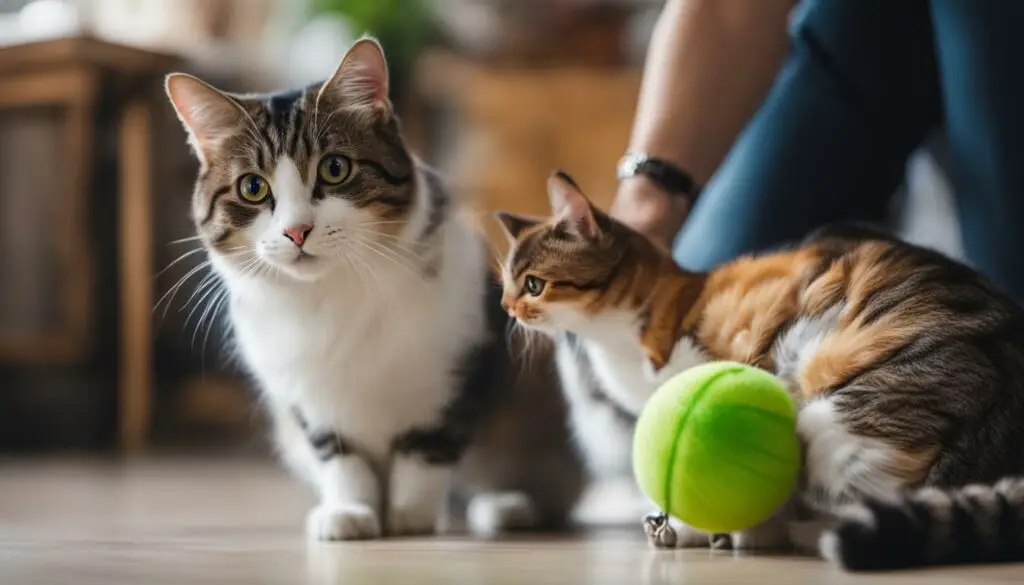
| Body Language Cue | Meaning |
|---|---|
| Tail Position | Relaxed tail: Contentment Upright, puffed-up tail: Aggression or fear |
| Ear Position | Forward-facing ears: Curiosity and attentiveness Flattened or backward ears: Fear or aggression |
| Pupil Size | Dilated pupils: Excitement, fear, or anticipation Constricted pupils: Aggression or anxiety |
| Body Posture | Crouched or hunched posture: Fear or submission Arched back and bristled fur: Aggression or defensiveness |
| Eye Contact | Direct eye contact: Challenge or threat Slow blinking: Trust and relaxation |
Cat Breeds and Vocalization Differences
Some cats are more talkative than others, and this can vary depending on their breed. Certain cat breeds are known for being naturally vocal and expressive, using a wider range of meows and vocalizations to communicate with their humans. These talkative cat breeds often enjoy engaging in conversations and expressing their thoughts and emotions through their unique vocalizations.
One example of a vocal cat breed is the Siamese. Siamese cats are renowned for their chatty nature and extensive vocabulary. They have a distinct, loud, and melodic voice, which they use to communicate various needs and desires. Siamese cats can be quite demanding with their meows and may often engage in long conversations with their owners.
Another talkative breed is the Burmese. These cats are known for their friendly and social nature, and they use their voices to engage with their human companions. Burmese cats are often described as having a soft, sweet, and gentle meow, which they employ to communicate their affection and seek attention.
“Cat breeds like Siamese and Burmese are known for their vocal tendencies and love for communication. These cats enjoy expressing themselves through their meows, making them excellent companions for those who appreciate a chatty feline friend.”
While not all vocal cat breeds have the same level of chattiness, understanding the communication tendencies of a specific breed can help you better appreciate and manage their unique vocal behavior. Keep in mind that talkative cat breeds may require additional mental and interactive stimulation to keep them engaged and satisfied.
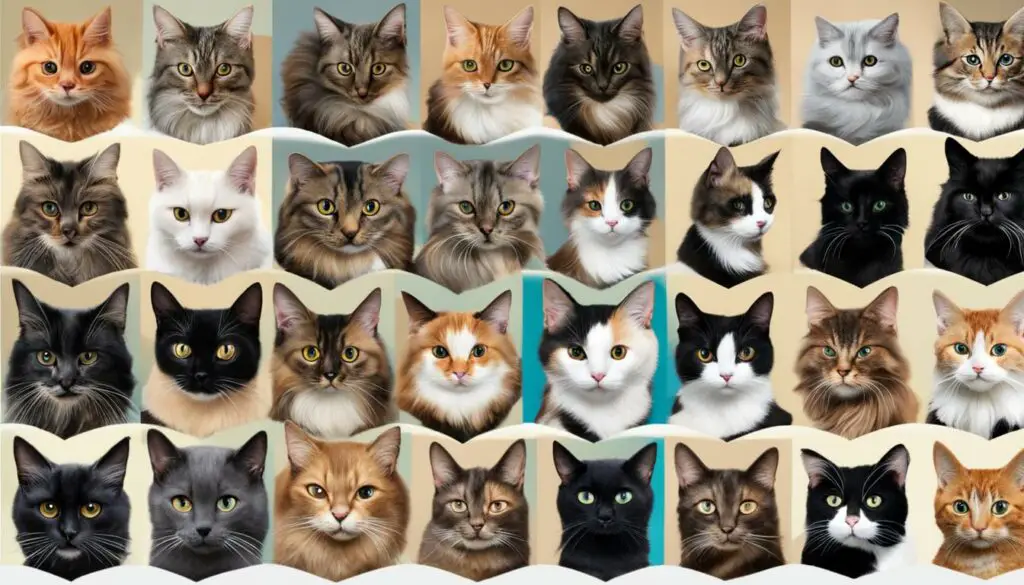
| Breed | Vocalization Tendency |
|---|---|
| Siamese | High |
| Burmese | Medium |
| Maine Coon | Low |
| Persian | Low |
| Sphynx | High |
Table: Vocalization tendencies in different cat breeds.
Paying Attention to Changes in Meowing Patterns
As cat owners, it’s important for us to monitor and observe our feline companions closely, paying particular attention to any changes in their meowing patterns. Cats communicate through various vocalizations, and their meows can provide valuable insight into their needs, emotions, and overall well-being.
Regularly observing and documenting your cat’s meowing habits can help you detect any unusual or sudden shifts in behavior. This can be done by keeping a journal or using a voice recorder to log the frequency, intensity, and context of their meows. By doing so, you’ll be better equipped to provide accurate information to your veterinarian if needed.
When monitoring your cat’s meowing, it’s essential to consider any accompanying behaviors or signs of distress. Cats may meow differently when they are in pain, feeling anxious, or experiencing medical issues. Look out for changes in appetite, litter box habits, grooming routines, and overall energy levels. Any drastic changes should be brought to the attention of your veterinarian.
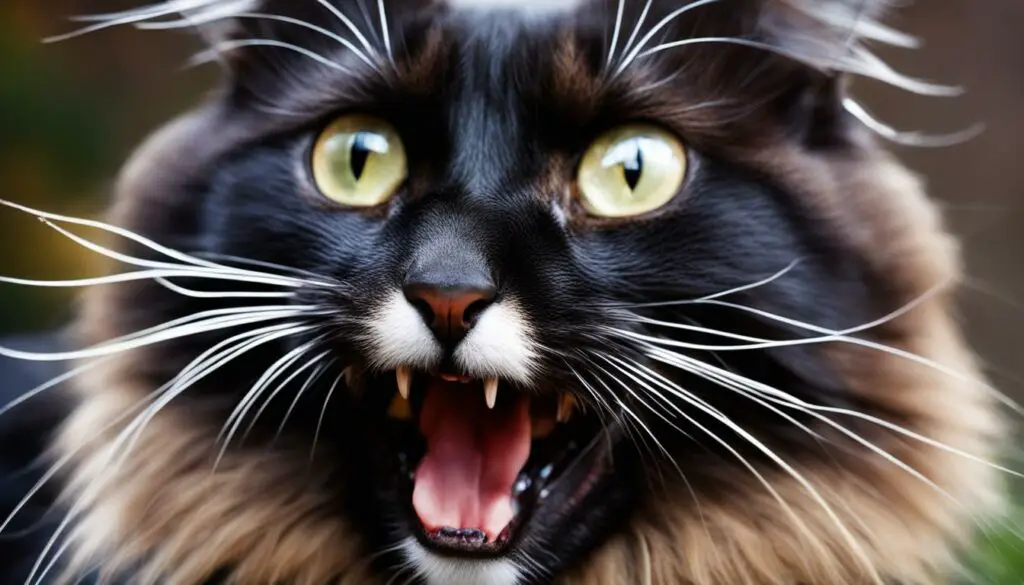
Additionally, it’s crucial to be aware of any external factors that may be influencing your cat’s meowing. For example, changes in the household routine, the presence of new pets or people, or even environmental stressors like loud noises or construction work can all impact your cat’s behavior and vocalizations.
By consistently monitoring your cat’s meowing patterns, you can stay attuned to their needs and address any potential issues promptly. Remember, you are your cat’s voice, so it’s essential to be proactive in understanding and responding to their unique communication cues. Through close observation and attentive care, you can ensure a harmonious and fulfilling relationship with your feline friend.
Conclusion
In conclusion, cats use meowing as a form of communication with humans. Their meows can have different meanings, such as greeting, seeking attention, expressing happiness or distress, and indicating health issues. Understanding the context and accompanying body language is crucial in interpreting their messages.
Cats meow primarily to humans, as it is a unique language they have developed for human interaction. They meow to engage and communicate their needs, desires, or simply to initiate contact. By responding to their meows and providing the attention they seek, you can strengthen the bond and relationship between you and your cat.
Monitoring changes in their meowing patterns is essential. Sudden shifts may indicate underlying health issues or emotional distress. Regular observation and seeking veterinary advice when necessary ensure their overall well-being and improved communication with your feline companion.
FAQ
Why does my cat only meow at me?
Cats primarily meow to humans, not to other cats. Meowing is a form of communication that cats have developed to interact with their human companions. It’s their way of trying to engage and communicate their needs, desires, or simply to initiate contact with humans.
What do different types of meows mean?
Meows can have different meanings based on the situation. A short meow can be a greeting, while a long, drawn-out meow could indicate a request for attention or something specific like food. Cats may also use repetitive meows to communicate their need for attention or engage in playtime.
Why do cats meow for attention and connection?
Cats often meow to seek attention and connection with their human companions. They meow to express their desire for play, petting, or simply to share moments of interaction. Meowing is their way of engaging with you and creating a bond.
What do distressed meows indicate?
Distressed meows are different from regular meowing patterns and can indicate that something is wrong. Cats may meow in a distressed or agitated manner when they are in pain, scared, or facing a stressful situation.
Can changes in meowing patterns be a sign of health issues?
Yes, changes in your cat’s meowing patterns can often be an indication of underlying health issues. If your cat starts meowing more or less frequently, or if their meows change in pitch or intensity, it’s crucial to consult with a veterinarian.
How can I communicate with my cat?
Cats appreciate the interaction and attention received when you talk to them. Speaking calmly and maintaining consistent body language can establish effective communication with your cat. Understanding their body language cues and observing their reactions to your voice tone can help strengthen the bond between you and your feline friend.
How can I enhance communication with my cat through scent and touch?
Allowing your cat to rub against you and share scents helps them feel connected and secure in your presence. By responding positively to their scent-marking behavior and providing gentle touch, you can enhance communication and deepen the bond with your cat.
Why is a consistent tone and positive reinforcement important when communicating with cats?
Cats are sensitive to emotions and cues from their human companions. Maintaining a calm and positive tone of voice is essential during interactions with your cat. Positive reinforcement and rewards for desired behaviors can foster a more positive and effective communication experience.
How can I decode my cat’s body language to better understand their needs?
Understanding cat body language can provide valuable insights into their needs and emotions. Observing ear position, tail movements, and pupil size can give clues about their mood and intentions.
Are some cat breeds more vocal than others?
Yes, some cat breeds, like Siamese cats, are naturally more vocal than others. Talkative cat breeds may exhibit more frequent and varied meows as part of their inherent communication tendencies.
Why should I pay attention to changes in my cat’s meowing patterns?
Sudden shifts in meowing behavior can indicate underlying health issues or emotional distress. Regularly observing and documenting their meows and accompanying behaviors can help detect changes and provide valuable information when seeking veterinary assistance.
Source Links
- https://www.rd.com/article/why-do-cats-meow/
- https://www.insider.com/guides/pets/why-do-cats-meow
- https://be.chewy.com/is-this-normal-why-do-cats-meow-back-when-you-talk-to-them/

